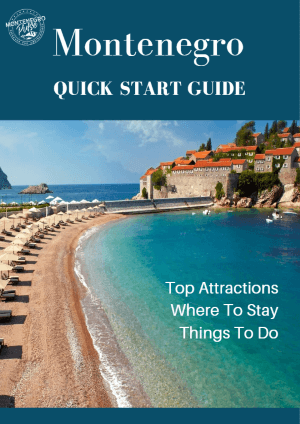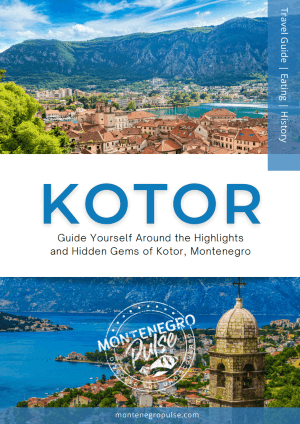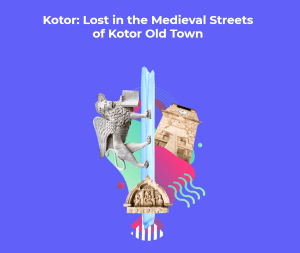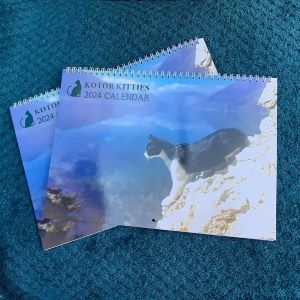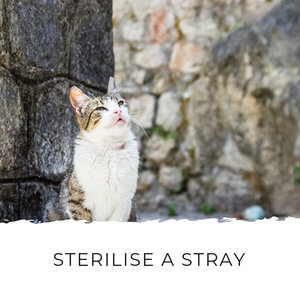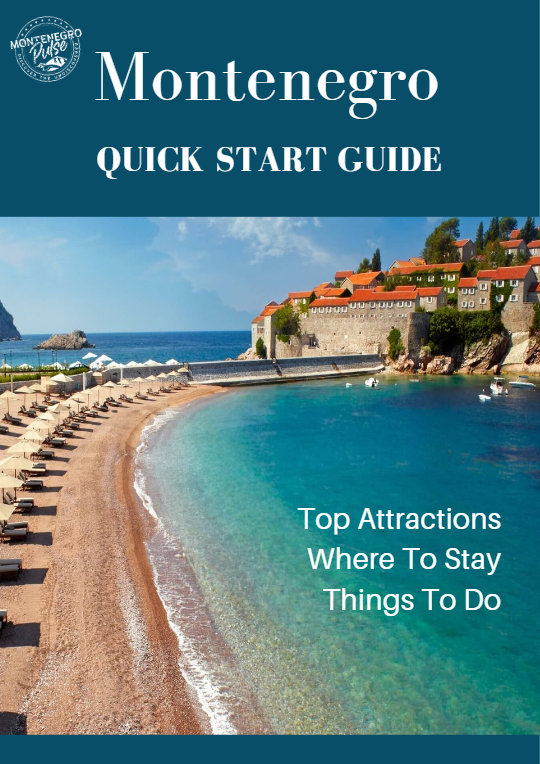Montenegro Pulse contains affiliate links and is a member of the Amazon Services LLC Associates Program. If you make a purchase using one of these links, I may receive compensation at no extra cost to you. See my disclaimer for more information.
Weather in Montenegro in January: What to Wear, What to Pack and More Visiting Tips
The weather in Montenegro in January is cool but mixed, so knowing what to expect is key to planning your trip to Montenegro in winter.
Montenegro has two distinct regions: the coastal region and the mountain region. You can expect very different weather in these regions, so knowing where you are going will also help you to pack for your trip.
To help you prepare for visiting Montenegro in winter, I’ve put together some information on what kind of temperatures you can expect in each region.
I’ve also included tips on what to pack (including one important do-not-pack item!) and some of the best things to do in Montenegro in January.
Read on to find out how to prepare for your trip to Montenegro in January.
Typical Weather in Montenegro in January
Coastal Areas
- Average High in January: 13°C (55°F)
- Average Low in January: 6°C (43°F)
- Average Monthly Rainfall: 191 mm (7.5 inches)
- Average Sea Temperature in January: 14°C (57°F)
The weather in the coastal region is typical Mediterranean, meaning it is cool, but it’s not as cold as elsewhere in Europe. It can also be wet.
You can expect daytime temperatures around 8°C to 12°C (46°F to 54°F. Nighttime temperatures are cooler, but it rarely goes below 2°C to 3°C (35.6°F to 37.4°F).
We also get brilliantly sunny days which are perfect for sitting in outdoor cafes in the winter sun.
Sometimes these sunny days are cooled by the freezing bura wind which comes down from the mountains, but just as often they're pleasantly warm.
On dry days I recommend taking a Kotor walking tour and exploring coastal towns like Perast, Budva, and Herceg Novi.
Kotor Bay Aquarium and the Roman Mosaics are great rainy day activities.
You'll also find Christmas light displays in all towns. I particularly like those in Kotor, Porto Montenegro in Tivat, and Portonovi in Herceg Novi.
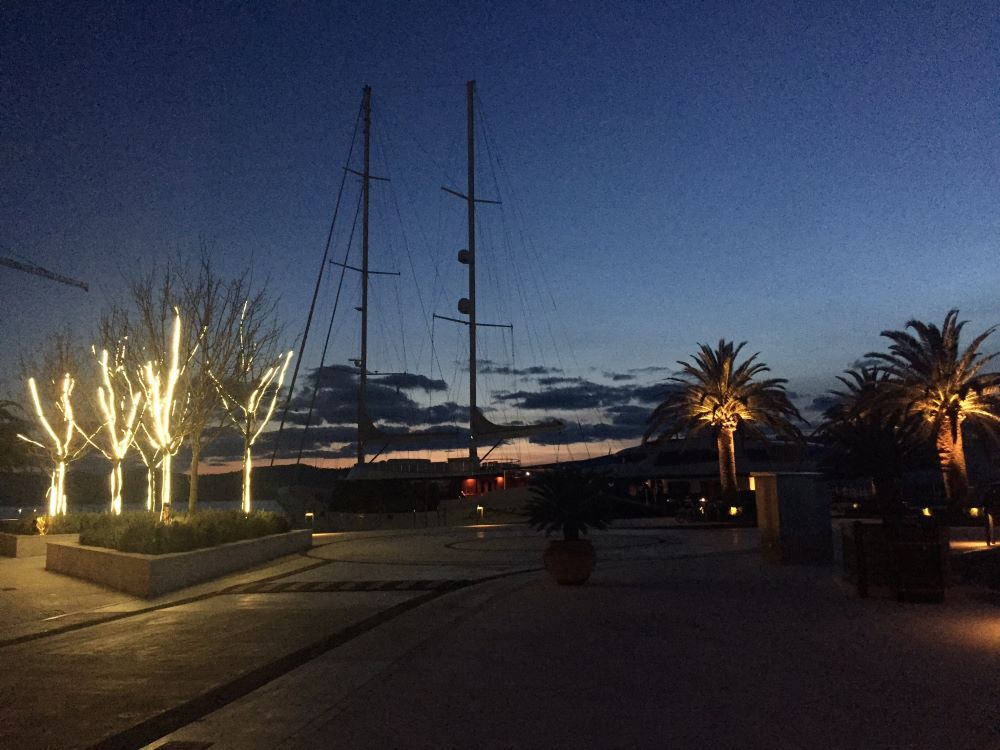 Porto Montenegro in January
Porto Montenegro in JanuaryPodgorica
- Average High in January: 10°C (50°F)
- Average Low in January: 1°C (34°F)
- Average Monthly Rainfall: Approximately 190 mm (7.5 inches)
Being inland, Podgorica has a cooler climate than on the coast, but not as severe as in the mountains.
Winter weather here is relatively mild compared to many other European cities. While the city does get snow, it's not common. Still, it pays to prepared for it if you're visiting Podgorica in winter.
Since this rainy season, you're more likely to have wet days in the capital. You can prepare for this by planning a mix of indoor and outdoor activities.
For example, on rainy days you can visit Montenegro's largest winery. On dry days, you can take a city tour or tour to see some of the top sights around Podgorica.
Northern Region
- Average High in January: 3°C (37°F)
- Average Low in January: -5°C (23°F)
- Average Monthly Precipitation: Approximately 195 mm (7.7 inches)
In January, Montenegro's northern region is cold, but beautiful. You'll find temperatures often below freezing, ranging from -5°C (23°F) to 3°C (37°F).
Snow covers the mountains and Žabljak and Kolašin become popular ski resorts. Both of these towns get busy during the first two weeks of January, which is winter break time in Europe.
Durmitor National Park and Biogradska Gora National Park are both beautiful under snow.
If you're driving, winter tires are mandatory, and carrying chains is a good idea if you're heading into snowy areas. Click here to find out more about driving in Montenegro.
What to Pack for January in Montenegro
Coastal Areas
The Adriatic coast enjoys milder temperatures, but you will still need to bundle up.
You'll need a waterproof jacket for rainy days. You'll also need warm sweaters and long-sleeved tops for layering.
The bura wind is a cold and often strong northeasterly wind that can bring sunny weather but significantly lower temperatures, especially along the Adriatic coast. I usually wear sunglasses, a hat, a scarf, and a warm jacket on these days.
I don’t usually wear gloves in the daytime at this time of year, but they can be useful if you’re going out at night.
Don't forget comfortable walking shoes for exploring the towns and waterproof shoes or boots for wet days.
Packing List for the Coast of Montenegro:
- Waterproof jacket with a hood, medium weight to keep you warm
- Warm sweaters
- Light-weight, long-sleeved tops
- Comfortable shoes for walking
- Waterproof shoes or boots - I live in these Sorel boots over winter in Montenegro. They’re warm, waterproof, comfortable, and stylish!
- Jeans or trousers
- Scarf
- Hat and gloves
- Umbrella
- Plug converter - We have this power strip converter this power strip converter for our North American guests. I love that can handle several devices at once. It’s ideal for families bringing multiple devices!
- Travel insurance - this is a must when traveling to Montenegro. Not only will it cover things like lost luggage and flight delays, but more importantly, any medical issues that you might have.
Montenegro’s public health system is rather poor, so I always recommend going private if you have any issues while you’re here and travel insurance will cover that.
Having medical evacuation cover is essential in Montenegro because if you have any serious issues you may need to be transported to another country.
I like Safety Wing’s Nomad Insurance (you can buy it just for a trip) because it’s the best value and most comprehensive cover I’ve found so far.
What Not to Pack:
- Hair straightener/curling irons - In Europe, the voltage is 220, while in the US and Canada, it’s 110. Most electronic devices such as cell phones, laptops, and electric shavers are dual voltage by default, so you can use them with a simple plug converter.
Unfortunately, hair straighteners and curlers use very high wattage and do not usually come with a dual-voltage setting, which means they won’t work in Europe.
Or rather, you’ll fry your appliance and short-circuit your hotel room!
If you can’t use your own hair appliances, your best option is to bring a dual-wattage straightener that will work in Europe and North America.
Inland Regions
In Montenegro's inland regions, January means embracing the cold.
You'll need a heavy coat to shield you from the freezing temperatures, especially at night. Layering is key: start with thermal underwear, add a fleece or wool sweater, and top it off with a thick, insulated jacket.
Waterproof and insulated boots are a must to keep your feet warm and dry in the snow. Don't forget a warm hat, gloves, and a scarf to protect against the cold. Sunglasses can be useful too, especially on bright, snowy days.
Packing List for Inland Montenegro:
- Heavy-duty winter jacket
- Waterproof snow pants
- Thermal layers
- Warm sweaters
- Jeans or trousers
- High-quality gloves
- Warm hat
- Waterproof boots with good grip
Top Things to Do in Montenegro in January
- Skiing and snowboarding: Head to one of Montenegro’s ski fields to make the most of the cold weather. Savin Kuk near Žabljak and Kolašin 1450 and 1600 in Kolašin are Montenegro’s top ski fields, but there are also small fields called Vučje and Hajla.
- Kotor Old Town: Kotor is a must-see any time of year in Montenegro. In January, it is decorated with lights for the holiday season, making it even more beautiful. Find out what to see in Kotor Old Town here.
- Orthodox Christmas and New Year: Celebrated on January 7th (Christmas) 14th (New Year), these celebrations bring fireworks and traditional customs around the country.
- See the lights: Because many Montenegrins celebrate Christmas and New Year in January, you’ll find most towns with lighting displays throughout the month.
Head to any town center, like Kotor, Budva, or Herceg Novi to see the Christmas lights.
I love visiting Portonovi (in Herceg Novi) and Porto Montenegro (in Tivat) for the best displays. - Kotor Bay Aquarium: This family-friendly attraction in Kotor is a great activity for rainy days. Inside, you’ll find small but beautifully curated displays of Kotor Bay sea life. The touch pool with rays is a highlight! Find out more about the aquarium here.
- Lipa Cave: Lipa Cave is a family-friendly attraction you can visit any time of year. Find out more about Lipa Cave here.
- Cetinje: Cetinje is Montenegro’s old royal capital and where you’ll find the national museums and palaces. You can combine a visit here with Lipa Cave on sunny or rainy days. Read more about what to see in Cetinje here.
More Fun Things to Do in January
Hotel Deals
January is low season in Montenegro, so it’s a great time to find some deals on accommodation. While many places close down over winter, those that stay open offer great rates.
Click the links below to visit Booking.com or VRBO to find a great deal and read recent guest reviews before you book.
Booking.com: Find great deals all over Montenegro for your upcoming stay!
Vrbo: Find a comfortable vacation rental through Vrbo and feel more like a local. Find some great places to stay on Vrbo here.
- Home
- The Climate of Montenegro
- Weather in Montenegro in January



